Marine Life & Conservation
Japanese whaling ship rams Sea Shepherd boat in the South Pole after whale slaughter – watch video
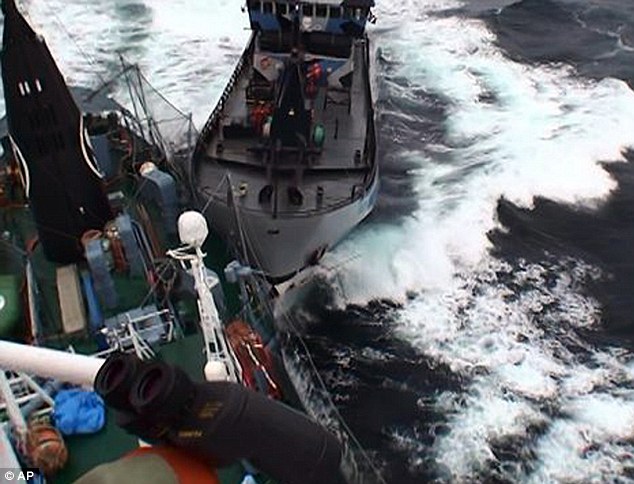
A Japanese harpoon whaling ship has rammed a conservationist protestors’ vessel in dramatic scenes in icy seas off Antarctica.
Video released by anti-whaling organisation, Sea Shepherd, shows the Japanese ship the Yushin Maru 2 crashing into the bow of the Bob Barker last week in the Southern Ocean off the South Pole.
Sea Shepherd claims the collision was deliberate and part of a sustained attack by three whaling ships on the protestors.
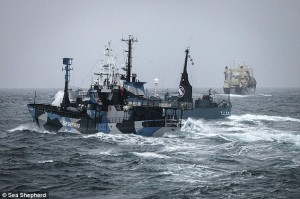 The Sea Shepherd boats, the Bob Barker and the Steve Irwin, were patrolling off Antarctica in the RossSea, the most pristine marine ecosystem on earth in which a high concentration of marine wildlife has remained mostly free from pollution, mining and fishing.
The Sea Shepherd boats, the Bob Barker and the Steve Irwin, were patrolling off Antarctica in the RossSea, the most pristine marine ecosystem on earth in which a high concentration of marine wildlife has remained mostly free from pollution, mining and fishing.
Known as “the last ocean”, the RossSea teems with large predatory fish, whales, seals and penguins.
The Sea Shepherd vessels had sailed to the Ross Sea to interfere with a Japanese whaling fleet comprising the Yushin Maru, Yushin Maru 2, Yushin Maru 3 and the world’s only whaling factory ship, the Nisshin Maru.
Sea Shepherd claims the Japanese ships launched a sustained eight hour attack from around 1am Australian Eastern Daylight Time (AEDT) on Sunday 2nd February.
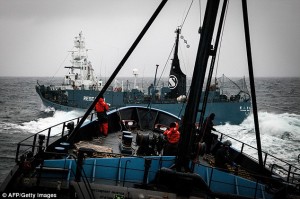 Sea Shepherd said its ships had positioned themselves off the Nisshin Maru’s slipway to block the harpoon vessels from loading the corpses of whales they had caught onto the factory ship.
Sea Shepherd said its ships had positioned themselves off the Nisshin Maru’s slipway to block the harpoon vessels from loading the corpses of whales they had caught onto the factory ship.
The Nisshin Maru is chartered by Japan’s Institute of Cetacean Research (ICR), which claims to be a nonprofit research organization of whales and dolphins, but which Sea Shepherd and Greenpeace say is just a Japanese Government-funded operation for slaughtering whales for profit.
In the attack, which continued until 9am, the harpoon vessels overtook the Sea Shepherd ships, crossing their bows and coming within three to five metres in numerous “dangerous manoeuvres”, Sea Shepherd claimed.
It said the Yushin Maru 3 struck the Bob Barker and quoted the ship’s captain, Peter Hammarstedt, and Siddarth Chakravarty of the Steve Irwin saying the two ships on several occasions had to steer out of the harpoon whalers’ paths, narrowly avoiding potential collisions.
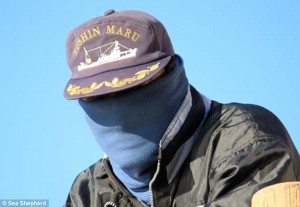 ‘The whaling vessels also made consecutive attempts to foul the propellers of the Sea Shepherd ships by dragging steel cable across the bow of the conservation ships,’ Sea Shepherd said.
‘The whaling vessels also made consecutive attempts to foul the propellers of the Sea Shepherd ships by dragging steel cable across the bow of the conservation ships,’ Sea Shepherd said.
Greenpeace claims the Nisshin Maru has twice rammed its vessel, the Arctic Sunrise, although the Institute for Cetacean Research contested Greenpeace was to blame.
ICR says on its website Greenpeace and Sea Shepherd engage in dangerous ‘sabotage’ which endangers life at sea.
‘Sea Shepherd group, one of several Greenpeace offshoots, joined the interference against Japan’s whale research and, imitating Greenpeace methods such as illegal boarding and ramming of research vessels, started to use increasingly dangerous and violent sabotage methods which include entangling devices (propeller foulers), throwing and shooting of chemical-containing projectiles, smoke bombs and incendiary devices,’ ICR said.
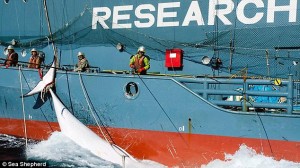 ‘Such dangerous actions by these groups are not peaceful protest but unforgivable acts akin to terrorism that threaten human life at sea.
‘Such dangerous actions by these groups are not peaceful protest but unforgivable acts akin to terrorism that threaten human life at sea.
‘Over and over again we have strongly condemned the harassment and sabotage actions by these groups and demand again that they refrain from further spreading violence under pretext of protecting whales.’
Sea Shepherd’s team of volunteers from around the world has photographed the ICR’s harpooning of whales, and slaughter of dolphins in the Japanese port of Taiji.
Australian Alana West told of the scene at Taiji last year, when the Japanese team herded a pod of striped dolphins into Taiji Cove and how she could hear ‘the distress cries of the dying pod members’.
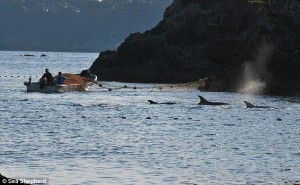 ‘Although the noise and confusion of the killing must have been terrifying for these dolphins, they did not swim to the other end of the Cove, as they so wanted to be with their pod members who were in fear and pain and were taking their last breaths,’ Alana said.
‘Although the noise and confusion of the killing must have been terrifying for these dolphins, they did not swim to the other end of the Cove, as they so wanted to be with their pod members who were in fear and pain and were taking their last breaths,’ Alana said.
‘It was incredibly harrowing to witness.’
Source: www.dailymail.co.uk
Here is the video:
[youtube id=”7QCKpq15qTI” width=”100%” height=”400px”]
Blogs
Invitation from The Ocean Cleanup for San Francisco port call

6 years ago, The Ocean Cleanup set sail for the Great Pacific Garbage Patch with one goal: to develop the technology to be able to relegate the patch to the history books. On 6 September 2024, The Ocean Cleanup fleet returns to San Francisco bringing with it System 03 to announce the next phase of the cleanup of the Great Pacific Garbage Patch and to offer you a chance to view our cleanup system up-close and personal.
We look forward to seeing you there.
To confirm your presence, please RSVP to press@theoceancleanup.com
PROGRAM
Join The Ocean Cleanup as our two iconic ships and the extraction System 03 return to San Francisco, 6 years and over 100 extractions after we set sail, to create and validate the technology needed to rid the oceans of plastic.
Our founder and CEO, Boyan Slat, will announce the next steps for the cleanup of the Great Pacific Garbage Patch. Giving you a chance to view our cleanup system and the plastic extracted.
Hear important news on what’s next in the mission of The Ocean Cleanup as it seeks to make its mission of ridding the world’s oceans of plastic an achievable and realistic goal.
Interviews and vessel tours are available on request.
PRACTICALITIES
Date: September 6, 2024
Press conference: 12 pm (noon)
Location: The Exploratorium (Google Maps)
Pier 15 (Embarcadero at Green Street), San Francisco, CA
Parking: Visit The Exploratorium’s website for details.
RSVP: press@theoceancleanup.com
Video & photo material from several viewing spots around the bay
We look forward to seeing you there!
ABOUT THE OCEAN CLEANUP
The Ocean Cleanup is an international non-profit that develops and scales technologies to rid the world’s oceans of plastic. They aim to achieve this goal through a dual strategy: intercepting in rivers to stop the flow and cleaning up what has already accumulated in the ocean. For the latter, The Ocean Cleanup develops and deploys large-scale systems to efficiently concentrate the plastic for periodic removal. This plastic is tracked and traced to certify claims of origin when recycling it into new products. To curb the tide via rivers, The Ocean Cleanup has developed Interceptor™ Solutions to halt and extract riverine plastic before it reaches the ocean. As of June 2024, the non-profit has collected over 12 million kilograms (26.4 million pounds) of plastic from aquatic ecosystems around the world. Founded in 2013 by Boyan Slat, The Ocean Cleanup now employs a broadly multi-disciplined team of approximately 140. The foundation is headquartered in Rotterdam, the Netherlands, and opened its first regional office in Kuala Lumpur, Malaysia, in 2023.
Find out more about The Ocean Cleanup at www.theoceancleanup.com.
Marine Life & Conservation
SHARK MONTH ARRIVES AT ROYAL WILLIAM YARD, PLYMOUTH

A shark has been spotted approaching Royal William Yard in Plymouth, much to the surprise of swimmers, paddleboarders and onlookers.
With its distinctive dorsal fin cutting through the water, the sizeable shark swam along the coastline, before turning to head inland towards Firestone Arch at Royal William Yard. The appearance drew a crowd, who were captivated for more than an hour by the unusual sight – and it was all caught on video.
The shark is one of many expected sightings at Royal William Yard over the coming weeks… because today marks the start of Shark Month!
In reality, the ‘shark’ spotted along the Plymouth shoreline was actually a custom-made model, created by the team at Royal William Yard and sailed underwater by Caroline Robertson‑Brown from the Shark Trust, who donned scuba diving gear for the occasion.
The stunt took place to launch Shark Month in style and draw attention to the work of the leading international conservation charity, which is based in Britain’s Ocean City. Spectators were reassured that the water was safe and many entered into the spirit of the performance, swimming or sailing alongside the shark.
Shark Month will take place across Royal William Yard throughout July and will feature an extravaganza of art, entertainment and advocacy for everyone to enjoy. The packed programme of events starts with an art exhibition and ends with a trip on paddleboards with shark experts – with everything from a shark quiz to a Jaws screening in between.
Paul Cox, CEO of the Shark Trust, said: “There are often assumptions and misconceptions when it comes to sharks. This was certainly the case with the shark spotted at Royal William Yard! While the British coastline is home to many species of shark, this was not one of them. However, we’re thrilled it caught people’s attention, because seeing a shark is a special and memorable moment. That is precisely why we want to celebrate these incredible creatures, highlight the need for conservation, and ask for help to safeguard their future.”
For more information about Shark Month at Royal William Yard, visit the Shark Trust Website.
Images and video: Jay Stone
-

 Blogs2 months ago
Blogs2 months agoDiving With… Nico, Ocean Earth Travels, Indonesia
-

 News1 month ago
News1 month agoMurex Bangka Announce New Oceanfront Cottages & Beachfront Dining
-

 Blogs2 months ago
Blogs2 months agoA new idea in freediving from RAID
-

 Marine Life & Conservation1 month ago
Marine Life & Conservation1 month agoIceland issue millionaire whale hunter a licence to murder 128 vulnerable fin whales
-

 Marine Life & Conservation2 months ago
Marine Life & Conservation2 months agoThe Shark Trust Great Shark Snapshot is back
-

 News3 months ago
News3 months agoCharting New Waters; NovoScuba Goes Global with the Launch of their Revolutionary Dive Training Agency!
-

 Gear News1 month ago
Gear News1 month agoNew Suunto Ocean – a dive computer and GPS sports watch in one for adventures below and above the surface
-

 Marine Life & Conservation Blogs2 months ago
Marine Life & Conservation Blogs2 months agoBook Review: Plankton
















